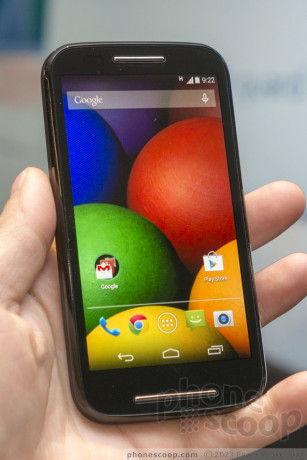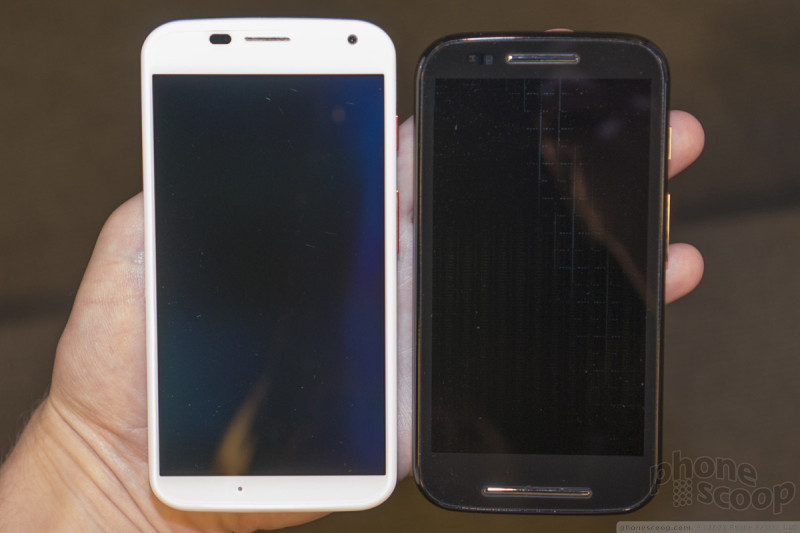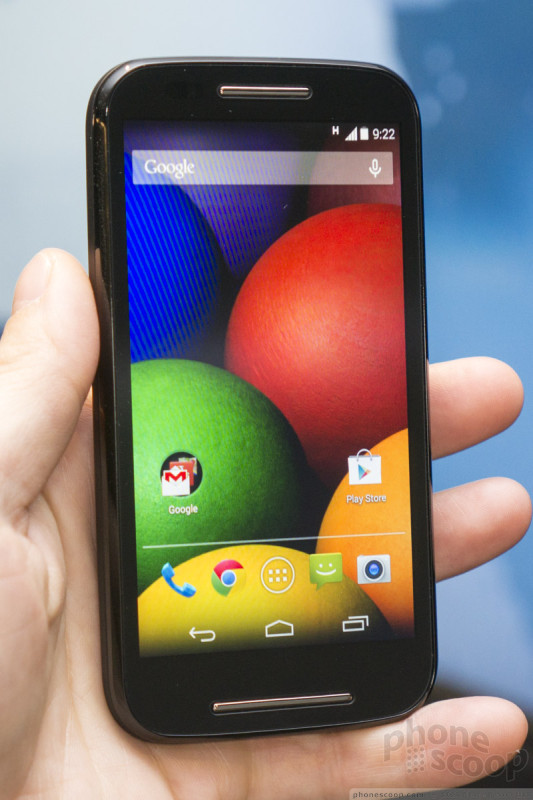Hands-On: Motorola Moto E
May 13, 2014, 9:34 AM by Eric M. Zeman

Motorola today revealed the Moto E, a low-cost Android smartphone that offers better specs and a lower price than much of the competition. Here are our first impressions.
source: Motorola
The Moto E takes the idea of low-cost smartphones to a whole new level. As it did with the Moto G, Motorola has redefined once again just what an inexpensive handset can offer. Here are our first impressions of the Moto E.
Motorola's newer smartphones - the X, G, and now the E - share the same basic look and feel. They have soft, comfortable plastics, compact footprints, and easy one-handed use. From a distance it would be hard to tell the three apart. The G is the largest and thickest of the three handsets, while the X is slightly smaller and thinner, and the E is smaller yet than the X, but closer in thickness to the G. The E doesn't use the best materials on earth, but it manages to avoid feeling or looking cheap.

As with the G, the front of the E is rather plain, but the footprint is great. The E has the same contoured shape of the Moto X/G. Motorola said that the sculpted shape of the back surface helps the phone fit better in the hand. It's not terribly thick or atrociously heavy, but it's not slender, either. The silky smoothness of the battery cover is pleasant against the skin.
The sides are rounded to meet the glass panel on the front. The plastics come up above the glass just a smidge in order to create a lip that circles the front. This lip serves to protect the screen when placed on flat surfaces. The lip is the only thing about the E that isn't smooth. Otherwise, there are no hard edges or corners. There's no denying that it's a comfortable device to hold and use. It's very easy to reach any part of the screen with your thumb. It will easily fit into any pocket.
Since the E is so compact, the 4.3-inch display fills up a significant portion of the front face. Motorola did a good job eliminating the bezel. There are two chrome bands - one at the top and one at the bottom - housing the earpiece speaker and speakerphone/microphone, respectively.
There are only two physical controls and both are on the right edge of the E. The screen lock key is nearest the top and the volume toggle is below it, closer to the middle. Both buttons have an excellent profile, making them easy to find. The travel and feedback is also quite good. The stereo headphone jack is on top and the microUSB port is on the bottom. There is no dedicated camera button.
The E's back can be removed, but you're not swapping out the battery. The battery is sadly enclosed. The cover is quite difficult to remove. Speaking of which, the covers are replaceable. Motorola is offering 20 different rear shells that allow people to customize the look of their phone. The shells come in a variety of colors and will cost about $20, give or take. Otherwise, the E comes in either white or black. The SIM card is tucked into the right edge of the phone and can be removed by pressing it inward with your thumbnail. Ditto for the microSD card slot, which is a nice addition and improvement when compared with the original Moto G.
The Moto E's screen is impressive for this class of device. It measures 4.3 inches and rates qHD (960 x 540) resolution. Most other devices in this class are still rocking 800 x 480 or even 480 x 320 screens, so the Moto E crushes the competition in this regard. Interestingly, the screen reveals a grid-like pattern under certain lights. According to Motorola, the grid is the actual touch-screen panel. It is mostly only visible with the screen off, but can still be spied at certain angles with the screen on. It's not terribly noticeable, but we thought it was worth mentioning.
The user interface is basically stock Android 4.4.2 KitKat with Motorola's core apps, such as Moto Assist and Moto Migrate tossed in for good measure. Motorola is committing to updating the handset to at least one major new version of Android down the road, so that's a plus. If you're worried that the dual-core Snapdragon 200 won't offer solid performance, guess again. In the few moments we've spent with the phone, it showed no difficulty in running apps, transitioning screens, and so on. It didn't feel especially zippy, mind you, but it certainly didn't feel slow.
For $129, the Moto E represents a new value in the entry-level smartphone market.
Comments
No messages

















 Review: Motorola Moto E
Review: Motorola Moto E
 Motorola Redefines Entry-Level Smartphones with Moto E
Motorola Redefines Entry-Level Smartphones with Moto E
 Motorola Moto E (GSM, 1st gen.)
Motorola Moto E (GSM, 1st gen.)



